


A community of Augustinian hermits was established on this site outside Arco Etrusco in ca. 1256, soon after the formation of the order. Its new church and adjacent convent hosted the General Chapter of the Order in 1279 and again in 1303.
The original church seems to have been rectangular in plan with a polygonal apse. This apse was demolished in the 14th century, and the present transept and apse were built, considerably increasing the capacity of the church. The octagonal campanile was then built above the chapel to the left of the apse.
The Augustinian hermits of Santa Maria Novella (later San Benedetto dei Condotti), who moved to this nearby site from Santa Maria del Sasso, Montemalbe, outside Perugia in 1421, were subject to Sant’ Agostino.
Martin Luther celebrated Mass here in 1510, on his way to Rome.
Papal forces occupied the convent during the Salt War of 1540.
The church was effectively rebuilt at the turn of the 18th century, to a design by Stefano Cansacchi di Amelia. The project was completed in 1803, after a hiatus caused by the French occupation of Perugia. A number of the 14th century elements of the interior were recovered in 1945.
The Augustinian community was suppressed in 1810 and then, this time definitively, in 1860. The church now serves the parish, while the convent returned to military use: it now houses the Caserma Militare Braccio Fortebracci.
Facade

Interior

Apse and Crossing
Pre-Tridentine Arrangement
The high altar originally stood at the crossing of the church, with the friars' choir behind it.
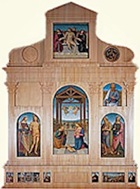
The altarpiece seems to have been part of a larger structure:
-
✴In 1512, the friars commissioned “una cassa per la tavola del altare maiure” from Giovanni Battista Bastoni, to a design by Perugino.
-
✴In 1520, they commissioned Eusebio da San Giorgio to complete the part of the structure that they termed the “cassa”,
There is some dispute about what this structure was: it is variously said to have been:
-
✴the frame of the predella;
-
✴a pair of doors that would cover the altarpiece except on special occasions; or
-
✴a partition around it that would complete the separation of their choir from the rest of the church.
Post-Tridentine Arrangement
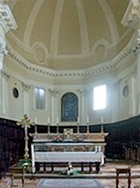
-
✴a large wooden tabernacle was placed in front of the polyptych (as seen from the nave) in 1580;
-
✴any structural elements that separated the choir from the body of the church would have been demolished at this point; and
-
✴the polyptych was dismantled in 1654, when the choir was relocated behind the altar.
Choir Stalls (1503)

Left Transept
The altar on the back wall of this transept was originally dedicated to St Lucy. This is in fact a partition wall; doors to the sides of the altars lead to the two original Gothic chapels behind:
-
✴the Cappella di San Nicolò da Tolentino (on the left), in which some frescoed aedicules have been exposed; and
-
✴the Cappella dei Consoli (on the right), in which an important fresco (14th century) of the Dormition of the Virgin has been rediscovered. This has been attributed to Allegretto Nuzi. [Unfortunately, this chapel is usually locked.]
Right Transept
The altar on the back wall of this transept was originally dedicated to St Nicholas of Tolentino. This is again a partition wall; doors to the sides of the altars lead to the two original Gothic chapels behind:
-
✴the Cappella dell’ Incoronazione (on the left); and
-
✴the Cappella dello Spirito Santo (on the right).


Frescoes (14th century) in the Frescoes (14th century) in the
Cappella dell' Incoronazione Cappella dello Spirito Santo
Fresco Fragment (1398)

Lamentation (late 14th century)

This fresco is in a niche in the Cappella del Crocifisso, on the transept side of the wall that separates the transept from the nave. It depicts the dead Christ being lowered on a sheet into a marble sarcophagus. The Virgin stoops to kiss Him, St Mary Magdalene holds His hand, and St John the Evangelist looks away in anguish. The figure of Joseph of Arimathea, who holds the sheet at the feet of Christ, is particularly fine.
Chapels on the Left
Frescoes (1377)






These frescoes in the Cappella di San Bartolomeo (2nd on the left) were discovered in 1945. They are signed by Pellino di Vannuccio and dated by inscription, and are the only known works by this artist.
-
✴The fresco on the back wall, which depicts Crucifixion with the Virgin and SS John the Evangelist and Mary Magdalene and a bishop saint, is the best preserved.
-
✴Other frescoes in the chapel include:
-
•the Nativity (on the right, illustrated above);
-
•a fragment of the Presentation of Christ (on the left); and
-
•figures of saints below the Crucifixion:
-
-St Herculanus (identified by inscription) on the left; and
-
-a female saint and St Jerome in his study on the right.
These frescoes were recently restored.
Madonna and Child with saints (1466)

Cappella di Santa Lucia Nuova
This chapel (4th on the left), which is also dedicated to St Rita of Cascia, was built in the 16th century to a design by a follower of Michele Sanmicheli.
Cappella di San Tommaso da Villanova (1523)

Madonna delle Grazie (early 16th century)

Nave
Panels

-
✴Christ and St Andrew (1551), on the left, illustrated here; and
-
✴the Martyrdom of St Catherine (1560) on the right.
[Where ?]
St Augustine in Meditation (17th century)
This altarpiece, which is attributed to Giovanni Francesco Bassotti, was documented on the high altar of the church of the nunnery of Santa Lucia on a number of occasions between 1683 and 1822. It was subsequently moved to Sant’ Agostino (presumably in 1851, when the complex of Santa Lucia passed to the the Conservatorio Antinori. [It is still there ?]
The altarpiece depicts St Augustine kneeling in a landscape and looking up at two visions: the Crucifixion, on the left; and the Immaculate Virgin, on the right. Three putti around him play with his book, his staff and his mitre.
Altarpieces (17th century)
Two altarpieces in Sant’ Agostino are attributed to Benedetto Bandiera:
-
✴the panel depicting St Michael, the Trinity and saints, [where ?]; and
-
✴the panel depicting a bishop saint giving alms to the poor, in the sacristy.
Art from the Church
Madonna di Sant' Agostino (early 14th century)

The Madonna is modelled as a full-length figure in regal costume, wearing a crown and carrying the baby Jesus on her hip. He is also regally dressed, and holds a bird in His right hand (probably a finch, which is a symbol of the Passion). Recent restoration has revealed the original polychrome decoration, which is in a good state of preservation that is unusual in a work of this age. The work is sometimes attributed to Ambrogio Maitani.
Stained glass (ca. 1345)
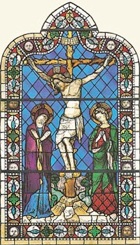
The original window has been attributed to Giovanni di Bonino on the basis of a comparison with the corresponding scene in the window at Orvieto (above), albeit that the iconography is different in the two works. (The cross in Orvieto is “Y” shaped). The Perugian window is usually dated to ca. 1345 because Giovanni di Bonino was called to Orvieto from Perugia in that year. However, some scholars believe that it predates the window in Orvieto.
Pentecost (1403)

The upper part of the panel depicts God the Father sending the Holy Spirit in the form of a dove to the Virgin and Apostles assembled below.
Panels from a Polyptych (early 15th century)
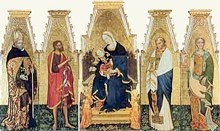
In 1791, Baldassare Orsini recorded the presence of these five panels in Sant’ Agostino. He also reported that:
-
✴two associated predella panels, which depicted the Crucifixion and the martyrdom of St Sebastian, were separately displayed; and that
-
✴the work came from San Benedetto dei Condotti (previously Santa Maria Novella).
The scroll at the foot of the throne in what was the central panel identifies the artist as Lello da Velletri.
It seems reasonable to suppose that the panels came from a polyptych that the hermits from Montemable commissioned for the high altar soon after they moved to Santa Maria Novella in 1421. They probably took the panels to Sant' Agostino in 1641, when Santa Maria Novella was ceded to the Sylvestrines. The main panels entered the Galleria Nazionale in 1863, by which time the predella panels had been lost.
All five panels are set in a flowery meadow, and each has a gold background:
-
✴The central panel depicts the Madonna and Child enthroned with two kneeling angels. The Madonna offers a small bunch of red and white flowers to the Child, signifying the Crucifixion.
-
✴The other panels depict saints whose identities are recorded by inscriptions in the haloes:
-
•St Augustine, whose Rule was followed by the Augustinian hermits;
-
•St John the Baptist, who probably commemorated Fra Battista da Gubbio, the prior who commissioned Santa Maria Novella and whose death possibly preceded the commission of the altarpiece;
-
•St Liberatore, who probably commemorated Fra Liberato di Simone, a monk from the earlier monastery on Montemalbe who was murdered in 1391; and
-
•St Agatha, who holds her severed breasts on a plate.
Madonna and Child with angels (1470s)

Tezi Altarpiece (1500)

The altarpiece was specified as the exemplar for an altarpiece that Bartolomeo di Lorenzo commissioned from Eusebio di San Giorgio for Sant’ Agostino in 1506. Perugino’s altarpiece remained in its original location until 1653, when it was moved and subsequently dismembered.
-
✴The main panel, which depicts the Madonna and Child with SS Nicholas of Tolentino and Bernardino, remained in the church until 1863, when it was transferred to the Galleria Nazionale.
-
✴The predella, which depicts the Last Supper, seems to have been a workshop production. It was probably stolen during the French occupation of Perugia in 1797. It turned up in a private collection in Frankfurt in 1833, when it was sold to the Staatliche Museen, Berlin. It is illustrated in this page from Wikipedia.
Panels from the Choir Stalls (1503)
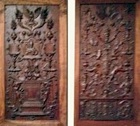
-
✴one depicts a bishop at his desk; while
-
✴the other is purely decorative.
Sant' Agostino Polyptych (1502-23)
Mattia di Tommaso da Reggio built the frame for this huge, double-sided altarpiece for the high altar in 1495-1500. Its design (reproduced above in modern reproduction) seems to have been based on that of Pintoricchio’s altarpiece in Santa Maria degli Angeli (or dei Fossi).
Perugino was commissioned in 1502 to paint some 30 panels for the polyptych. Progress was slow and the friars resorted to litigation, before renewing Perugino’s contract in 1512. They returned to the fray again in 1520, pressing Perugino to complete his work by 1521. It must have been largely complete by the time of his death in 1523 because his executors requested final payment. (As part of this final payment, the friars promised to move Perugino’s body from the Oratorio dell’ Annunziata, Fontignano to Sant’ Agostino, but this promise was never honoured.)
The altarpiece was dismantled in 1654 and its panels were displayed in various locations in the church. They were moved to a store room when the church was restored in 1794. Napoleon's commissioner, Jacques-Pierre Tinet selected seven of them for confiscation in 1797, and they were subsequently dispersed (see below). The remainder were moved to the Galleria Nazionale in 1863.
-
✴The restoration of the panels in the gallery in 1997 allowed their original locations within the frame and the sequence in which they were painted to be established.
-
✴The twelve panels in the double-sided predella were integral to the structure of the frame, and they were probably in place by 1512. Since Perugino had been away from Perugia for most of the period 1502-12, these panels were probably largely the work of his workshop.
-
✴The panels that formed the central register of the side of the altarpiece facing the nave seem to have been installed soon after 1512.
-
✴The panels that formed the central register of the side of the altarpiece facing the friars’ choir seem to have been painted and installed over an extended period that probably culminated in ca. 1520.
-
✴The last substantial panels to be painted seem to have been those of the two upper registers.
The probable reconstruction is illustrated in this page in Wikipedia.



-
✴God the Father (in the top register, exhibited here, illustrated above);
-
✴SS Philip and Augustine (now in the Musée des Augustins, Toulouse), with the Archangel Gabriel (exhibited here, illustrated above);
-
✴the Baptism of Christ (the main panel, exhibited here, illustrated to the right); and
-
✴SS Herculanus and James (now in the Musée des Beaux Arts, Lyon).
A panel of the Virgin Annunciate that was the pendant to the Archangel Gabriel was among those taken to France in 1797, but was subsequently lost.
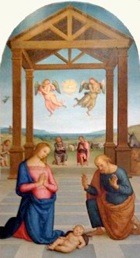

The main panels from the side of the polyptych facing the friars were:
-
✴the Pietà with the Virgin, St John the Evangelist and Joseph of Arimathea (taken to France in 1797 and returned to Perugia in 1816, when it was given to the monks of San Pietro);

-
-
-
-
-
✴SS Sebastian and Irene (now in the Musée des Beaux Arts, Grenoble), with a young saint (possibly St Martin of Tours) with a sword above (now in the Musée du Louvre, Paris) ;
-
✴the Adoration of the Shepherds (the main panel, exhibited here, illustrated above); and
-
✴SS Mary Magdalene and Jerome (exhibited here, illustrated above), with St Bartholomew above (now in the Museum of Art, Birmingham, Alabama).


The twelve predella panels are now in the gallery, although only two are displayed. They depict:
-
✴the presentation of Jesus at the Temple; and
-
✴the wedding at Cana.
Adoration of the Magi (1505)

Vasari's attribution of the panel to Eusebio da San Giorgio is generally accepted, although it is sometimes thought to have also involved at least one collaborator. (Eusebio repeated this composition in a documented altarpiece in San Pietro in 1509).
Capra Altarpiece (ca. 1505)

The most obvious interpretation was that Filippo di Benedetto had commissioned the altarpiece in memory of his father, the jurist Benedetto Capra, who had been granted a chapel in Sant’ Agostino in 1469 and who had died in 1470. However, this caused scholars some consternation, since the altarpiece is dated on stylistic grounds to ca. 1505. However, the confusion seems to have been caused by the fact that:
-
✴Filippo’s son was also called Benedetto; and
-
✴his son (i.e. the jurist’s great grandson) was also called Filippo.
It must have been this second Filippo di Benedetto who commissioned the altarpiece. Pietro Scarpellini attributed the work largely to Giovanni Battista Caporali (as referenced in the page on this artist), albeit that “Pietro [Perugino] intervened at the last moment to put his imprint on a work that came from his workshop” (my translation).
The altarpiece remained in its original location until 1653 and was then moved to other locations in the church. It was removed to the convent in 1794 before the start of the re-modelling of the church. Napoleon's commissioner, Jacques-Pierre Tinet selected it for confiscation in 1797:
-
✴The main panel, which depicts the Madonna and Child with SS Jerome and Augustine, was sent from Paris to Bordeaux in 1803. It is now in the Musée des Beaux-Arts, Bordeaux.
-
✴Two predella panels depicting miracles of St Nicholas of Tolentino, which might have belonged to this altarpiece or alternatively to that of the Coronation of St Nicholas of Tolentino by Raphael, found their way into the collection of Ralph Harman Booth (died 1931). His widow gave them to the Institute of Arts, Detroit, and they are illustrated in the institute's website.
Madonna and Child with saints (1509)
This altarpiece from Sant’ Agostino, which is dated by inscription, seems to be the work that Bartolomeo di Lorenzo commissioned from Eusebio da San Giorgio in 1506 for his family chapel here. The contract specified that it should be similar to what is now known as the Tezi Altarpiece (1500) by Perugino, which was also in Sant’ Agostino (above).
It was also probably the work that was specified as being underway in Eusebio’s workshop in Perugia in the contract that he signed in 1507 for the completion of the altarpiece by Pintoricchio in Sant’ Andrea, Spello: the contract allowed him to complete this existing commission but precluded him from leaving Spello for any other reason. The initials “LA SI” at the end of the inscription giving the date might indicate the involvement of two other members of the Workshop of 1496: Ludovico di Angelo and Sinibaldo Ibi.
The altarpiece, which depicts the Madonna and Child enthroned with SS Peter, Catherine of Alexandria, Agatha and Paul and two praying angels above, is now in the Galleria Nazionale.
Madonna and Child with saints (1543)
According to the inscriptions, Luca Alberto Podiani commissioned this altarpiece, which is dated by inscription. [Luca Alberto Podiani (1474-1551) was a celebrated doctor and scholar, rector of the Sapienza Vecchia in the period 1504-20.] The altarpiece, which is attributed to Sinibaldo Ibi, depicts the Madonna and Child enthroned with SS Francis and Leonard. Two flying angels above who hold a crown above the head of the Madonna.
The altarpiece entered the Accademia di Belle Arti in 1810 and is now in the Galleria Nazionale. There are at least two possibilities for its original location:
-
✴the Convento di Monteripido, where, according to his will of 1548, Luca wished to be buried; or
-
✴Sant’ Agostino, where Luca was actually buried in 1555, in his family chapel that was dedicated to St Leonard.
Madonna and Child with saints (1524)
Severo di Paride Petrini commissioned this altarpiece, which is dated by inscription, from Domenico Alfani for his family chapel, the Cappella di San Tommaso da Villanova (above). The final payment for the work was delayed until 1541. The altarpiece was removed from the chapel in 1799 church and passed to the Accademia di Belle Arti in 1810.
The altarpiece, which depicts the enthroned Madonna crowned by angels holding the hand of the standing, naked baby Jesus, with SS Peter, Paul, Nicholas of Bari and Lucy, is now in the deposit of the Galleria Nazionale.
Adoration of the Magi (1545)

The work was subsequently split into two panels:
-
✴the Visitation; and
-
✴the Adoration of the Magi (illustrated here).
The predella, which had an inscription bearing the date, was subsequently lost.
The two main panels then went their separate ways:
-
✴Dominique-Vivant Denon, the Director of the Musée Napoleon selected the Visitation for confiscation after the Napoleonic suppression of 1810, and it is still in what is now the Musée du Louvre, Paris.
-
✴The Adoration of the Magi remained in Sant' Agostino until 1863, when it entered the Galleria Nazionale.
Copy (16th century) of Raphael’s Pala Baglioni
This panel, which is attributed to Orazio Alfani, is the earliest known copy of the main panel of Raphael’s Deposition (1507). The original, which was still in San Francesco al Prato when this copy was made, was sold to Cardinal Scipione Borghese in 1608 and is now in the Galleria Borghese, Rome.
The copy was first recorded in the sacristy in 1863, the date at which it was transferred to the Galleria Nazionale. It was restored in 1970 and moved to its current location, the Oratorio di San Bernardino.
Holy Family with St John the Baptist (1560)
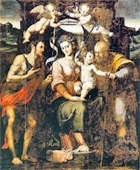
The altarpiece depicts the Madonna and Child enthroned with SS John the Baptist and Joseph, set in a landscape. St Joseph plays with the baby Jesus, and they both hold the flowering staff that is his traditional attribute of St Joseph. St John the Baptist seems to be reminding the Virgin of the baby’s fate, as two baby angels hold a crown above her head.
Birth of the Virgin (1561)

Organ Casing (1561)
Giacomo Maffei of Gubbio was commissioned to carve the organ casing of Sant’ Agostino, but this work was subsequently destroyed.
Madonna and child with saints (ca. 1580)

The altarpiece depicts the Madonna and Child enthroned with SS Antony Abbot and Lucy. The baby Jesus offers a palm of martyrdom to St Lucy while two flying angels hold a crown above the head of the Virgin.
Bust of Marcantonio Eugeni (ca. 1640)


